|
1929 |
|
On 13 March 1929,
movies with sound come to the theatre with
the feature Lucky Boy, a 1929 American musical comedy-drama film
directed by Norman Taurog and Charles C. Wilson and starring George
Jessel. The film was mainly a silent film
with synchronized music and sound effects, as well as some talking
sequences. This marked the end of an era
which meant the organ was no longer used nearly as much. |
|
|
1930s |
|
In 1932 a
short resurgence of the organ with the
“Indiana Theatre Organlogue” radio program. This new use for the organ
was sadly short-lived. Opus 493 remained intact
but silent for decades,
becoming a dust-covered relic. |
|
|
1960s |
In the late
1960s, Terre Haute musician and instructor Russell
W. McCoy (1917 - 1991)
uncovered the dusty console only to find the Wurlitzer in very
poor condition. McCoy, Paul Lewis, and Bill Westerman spent many late
night hours in the theatre cleaning and repairing the instrument.
Following their hard labour the organ was once again presented to the
public in a concert on September 30, 1967. Almost as short-lived as
the radio exposure in the early 1930s, this second revival was brief
in duration.
(photo Russ McCoy 1965/67) |
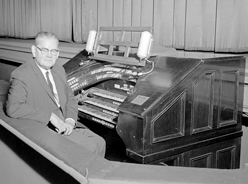 |
|
|
1970s |
|
The United Artist chain sold the organ
to Professor Richard Ertel (1939 - 1983) in Vincennes, Indiana. Ertel
bought the Organ and removed it during the week without the knowledge
of Mr. McCoy. He even took Mr. McCoy's Peterson tuner and tools that
were in the chamber. The organ was put into storage in a barn on a
dirt floor for many years. Many newspaper reports falsely stated the
organ was sold to Vincennes University, yet this was never the case.
The exact plans Mr. Ertel had for Opus 493 are not known, and no
project with the instrument ever came to be while under his ownership. |
|
|
1980s |
|
In 1983 Professor Richard Ertel died and the
organ was put up for sale. At that time CIC-ATOS sent Larry Mac
Pherson over to look at the instrument. He reported back that it was
in very bad condition and recommended the club not purchase the organ. |
|
|
1990s |
|
It was sold in the early 1990s to a
broker Roy A.Davis Jr. (1934-2018) (Roy Davis Pipe Organs), in
McMinnville, Tennessee who parted the instrument out.
Confirmation was published in the Terre Haute Tribune-Star on June 12,
1990 that the theatre had been purchased by William J. Decker. Mr.
Decker continued to operate the venue as a second-run movie theatre,
but he strongly desired to return the Indiana to her formal glory. He
even travelled to Tennessee to assess the condition and feasibility of
purchase and reinstallation of Opus 493. After finding the organ to be
in very bad condition, he realized the return of the once-integral
part of his theatre was not to be.
Bill Milligan
(1953-2002) Bill had totally torn the console down to restore it as a
digital organ, then died rather suddenly of a massive heart attack at
age 49. He was originally from Chicago, did a lot of pipe organ work
in the area and even abroad. He was a principal player and worked with
George Buck as manager audio/visual Services extensively on the
"Mightiest" project in DeKalb in the mid-80s.
Scott Smith
(Scott Smith Pipe Organs) was told by a colleague about the console
and some other pipe organ related goods, and wasted no time in
checking it out. It was the next-door neighbour of Bill; an older man, who was
parcelling everything out. Scott got the idea he was grateful that he
had
bought as much of that “weird pipe organ stuff” as he did. Bill had
totally torn the console down; presumably to repair and paint it for a
home digital organ. For hours, and on two separate occasions, Scott walked
around and around and around the garage-shop to find pieces of it here
and there. Even the pedal board was down to nothing. When Scott was finally
satisfied he had everything there was to be had, he left with the
assurance that if there was anything else, it was probably already in
the landfill. |
|
|
2000s |
|
21
August 2004 |
 Joel Martis of Joliet, Illinois bought the console from Scott
Smith. Joel Martis of Joliet, Illinois bought the console from Scott
Smith.
When the organ was bought, it was missing its back, front kick
board, music rest and swell shoes.
Joel at
the console of the Rialto Square Theatre Barton Grande 4/27 Sept
2021 |
August
2004
to
2008 |
Console:
Restoration and painting started 2004 and completed 2008 |
MIDI
input output uMIDI controller boards, LCD, cable and connector
kits and power supplies bought from Artisan
on the 24 August 2008. |
Keyboards:
The keyboards are original and before restored had real ivory on
them. The ivory was in such bad shape they had to be re-covered
using simulated Ivory “plastic” coverings.
New felt, springs and other parts were purchased and on the 15
March 2005 the keyboards were sent to Rick McGee in Atlanta, GA
for restoration. Completed 18 January 2008 |
Pedal Board:
3 swell shoes from Arndt Organ Supply, Peterson pedal contacts and
boards, 1st and 2nd touch. Two piano pedals and 20 Toe Pistons sent
to Rick McGee to restore. |
March 2009
to
June 2011 |
Horseshoe:
230 Stop Action Magnates, 28 pistons, 16 lighted pistons from
Syndyne, tab and piston engraving and other parts sent to Rick
McGee in March 2009 to restore. Completed June 2011. |
|
2012 |
Decorations
added |
|
2013 |
Saw the addition of two swing
out trays and later Toe Pistons |
| |
Due to problems with uMIDI
output cards changed Stop Action Magnet boards to DTS MIDI Systems
DC48 boards. |
|
|
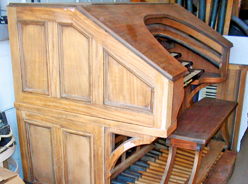 |
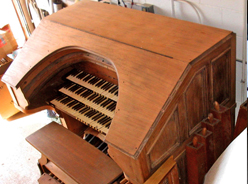 |
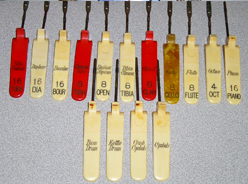 |
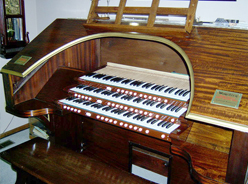 |
|
Condition of the organ when Joel Martis
bought the instrument in 2004 |
Original hand engraved Tabs
regretfully sold |
23 September 2008
Console and keyboard Complete |
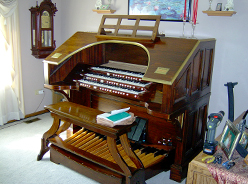 |
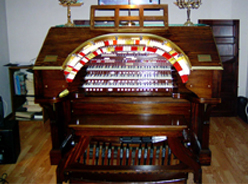 |
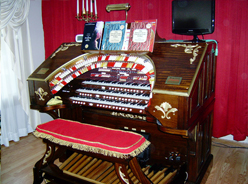 |
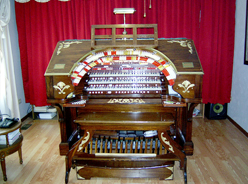 |
18 April 2010
Pedal board, Swell Shoes, Piano pedals completed |
Aug 2011
Horseshoe installed |
2012
Decorations installed |
March 2013
Swing out trays added |
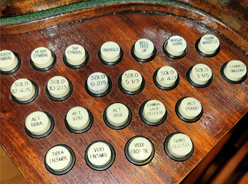 |
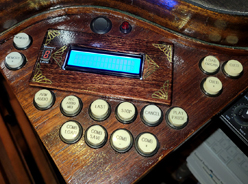 |
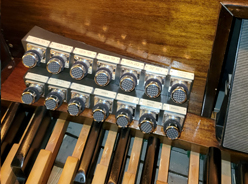 |
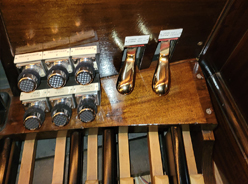 |
|
LH Swing out tray |
RH Swing out tray |
RH Toe Pistons |
RH Toe Pistons |
|
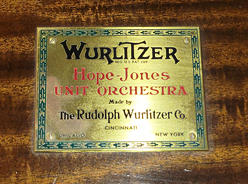 |
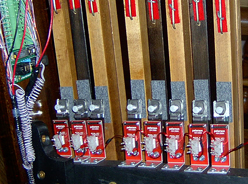 |
 |
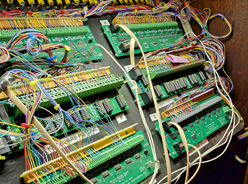 |
Wurlitzer Hope- Jones
Unit Orchestra plaque |
Peterson Contacts
first and second touch |
Console Close-up Nov 2021 |
Electronics |
|
Is this really Opus 493
Console from
the Indiana Theatre? |










